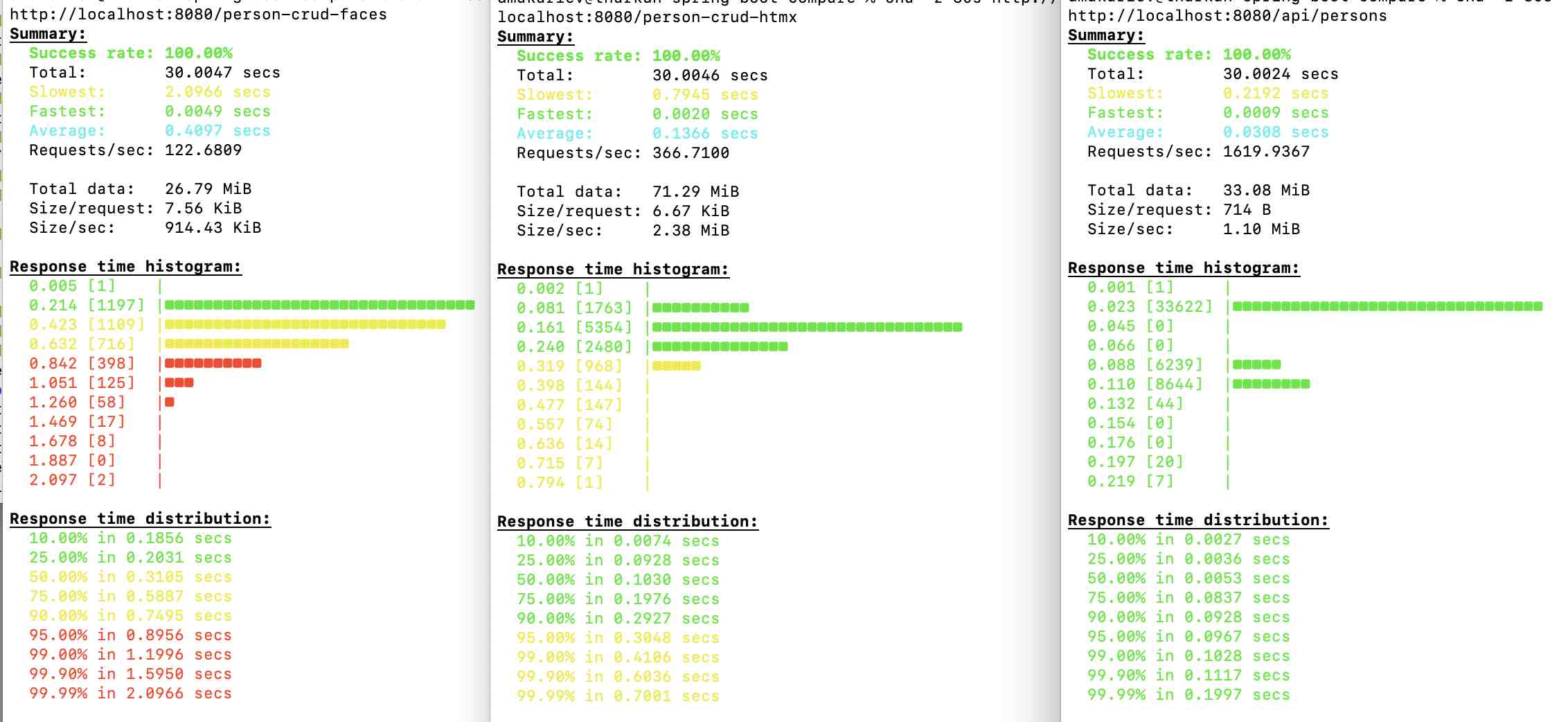Creating web applications with Spring Boot can be approached using different front-end technologies. This post compares three approaches: Vue.js, JakartaServer Faces (JSF), and Thymeleaf with HTMX, based on a series of tutorials
Related posts
The series includes the following posts:
- #nobuild Web Application Development with Spring Boot
- Creating a Web Application with Spring Boot and Vue.js
- Building a Web Application with Spring Boot and Jakarta Server Faces
- Creating a Web Application with Thymeleaf and HTMX
Performance Comparison
Performance tests were performed to compare these technologies. We’ve used https://github.com/hatoo/oha as load generating tool
- Minimal Docker configuration with JSF:
deploy: resources: limits: cpus: 1.0 memory: 640M reservations: cpus: 0.5 memory: 256M - Minimal Docker configuration without JSF:
deploy: resources: limits: cpus: 1.0 memory: 256M reservations: cpus: 0.5 memory: 256M
Spring Boot and Vue.js
Building with Vue.js involves using Vue CLI for scaffolding the project and creating a dynamic front-end. Vue.js excels in building SPAs (Single Page Applications), offering reactive data binding and a component-based architecture. Integration with Spring Boot is achieved via REST APIs, making this combination suitable for highly interactive applications.
Pros:
- Modern, reactive UI
- Component-based architecture
- Good for SPAs
Cons:
- Requires separate front-end build process
- Initial setup can be complex
Performance Test:
oha -z 30s http://localhost:8080/api/persons
- Requests/sec: 1619
- Average response time: 0.0308 secs
Spring Boot and JakartaServer Faces
Using JakartaServer Faces (JSF) allows for a component-based framework that integrates directly with Java EE. JSF manages UI components and state on the server side, simplifying the connection to backend services.
Pros:
- Rich server-side UI component model
- Simplified state management
- Direct integration with Java EE
Cons:
- Can be heavy and slower compared to modern JS frameworks
- Less flexible for highly dynamic interfaces
Performance Test:
oha -z 30s http://localhost:8080/person-crud-faces
- Requests/sec: 122
- Average response time: 0.4097 secs
Spring Boot, Thymeleaf, and HTMX
Combining Thymeleaf and HTMX offers a hybrid approach. Thymeleaf handles server-side rendering, while HTMX allows for dynamic content updates without full page reloads by leveraging HTML over AJAX.
Pros:
- Simplified setup with no separate front-end build
- Server-side rendering benefits
- Enhanced interactivity with minimal JavaScript
Cons:
- Less dynamic than a full SPA
- Limited to HTML over AJAX for interactivity
Performance Test:
oha -z 30s http://localhost:8080/person-crud-htmx
- Requests/sec: 366
- Average response time: 0.1366 secs
Conclusion
- Vue.js: Ideal for highly interactive SPAs needing a reactive UI.
- JSF: Best suited for server-centric applications requiring robust state management.
- Thymeleaf/HTMX: A balanced approach, enhancing traditional server-side rendering with modern interactivity.
Each approach has its strengths, and the best choice depends on project requirements and team expertise. For practical examples, explore the tutorials linked in each section.
My personal favorite is Spring Boot with Thymeleaf/HTMX. It offers good performance and can outperform traditional SPAs (Angular/React/Vue with JSON API) depending on implementation details. The major advantage is the elimination of code duplication in the front-end application.
Happy coding!
